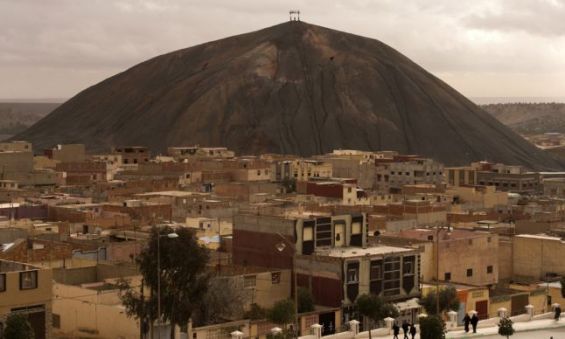Coal mining activities have made Jerada a city of workers who earned a living, fed their families and participated in boosting the country’s economy. However, their lives changed when the decision was made in 1998, to close the mines, putting an end to the coal extraction industry in the city. It was the beginning of a decline that impacted negatively the employment rate in the region and pushed so many families to just abandon the town that hosted them for years.
The World Bank loan
It all started when Charbonnage du Maroc (CdM), a state-owned company in charge of coal-mining in Jerada, asked the World Bank for help. The company was opting for a modernization and expansion plan intended to boost the production and improve exploitation. In a detailed study, the international financial institution that provides loans to countries of the world for capital programs explained the objectives of this project submitted in 1985. Entitled «JERADA COAL MINE MODERNIZATION AND EXPANSION PROJECT», the World Bank’s report indicates that CdM has asked for a USD 27 million loan «payable in 15 years, including four years of grace at that Bank standard variable interest rate».
With that money, CdM promised to back the «modernization and expansion of the Jerada mine from 0.8 mtpy to 1.0 mtpy by 1988 and the strengthening of its operational and planning capabilities». It has also pointed out that «it would concentrate production in a single mine, simplify the infrastructure of this mine for increased productivity and production, and improve safety, health and working conditions in the mine».
The abovementioned promises were made 8 years before the other World Bank report was released. After CdM’s bid was approved on the 21st 1985, the bank had issued another survey. Through the latter, the World Bank announced, in 1985, that «the Loan, made to Charbonnages du Maroc… closed on June 30, 1991, with total disbursements of US$ 13.5 million» had been canceled.
Explaining the reason behind that decision, the report stated that «the Project did not achieve its main objectives because of geological problems and lower coal prices than anticipated». For the institution, the company couldn’t meet its promises through its Modernization plan and although it «heiped to postpone the decline in production temporarily, the economic rate of return on the project was still negative, mainly due to the decline in production».
The failure of CdM’s project was also due to geological reasons that had to do with «low seam thickness, adverse inclination, cracks and faults basalt intrusions, dusty coal and high temperatures», wrote the same source.
After the closure
The aforementioned hindrances have eventually led to the closure of the mines and resulted in the end of Charbonnage du Maroc's activities. A turning event for the economy of Jerada that kept on going for years. The laid off workers had to either find another job a in the city that had almost nothing to offer but coal mining activities or leave for another region. Unfortunately, this is what happened according to Mustapha Selouani, a trade unionist based in Jerada. The UMT member told Yabiladi that nothing went as expected after the closure of the mines.
«When the mines were closed in 1998 and coal mining activities were abandoned, the government had promised to back the region and find ways to make it attractive again», he said. Two protocols were signed at the time to boost both the economic and social status of the miners in Jerada. «The social one (protocol or agreement) had the objective of providing several services for these workers such as housing, education, and the creation of job opportunities», said Selouani who added that «a museum was also expected to be founded to preserve the working aspect of the mineral city». Based on the trade unionist’s account, Charbonnage du Maroc’s assets were meant to be granted to the city as a compensation for the miners.
On the other hand, from an economic standpoint, the second protocol was set to relaunch the city’s economy after the closure of the mines. «The plan was to create job opportunities, bring investments», explained Selouani. On the phone, he insisted that contrary to expectations, not every single promise of these two protocols has been delivered.
«Jerada hosted workers who came from all over the Kingdom, such as Tiznit, Demnat, the Rif region, everywhere and the aim was to keep them there and not make them leave», he argued.
According to Selouani, the miners who received compensations left Jerada and started new lives outside the borders of the region. This was confirmed by official statistics provided by the National Observatory of Human Development (ONDH), a governmental agency, explaining how the population in Jerada dropped after the closure of the mines.
The exodus
According to the last census, conducted in 2014, only 43,506 people live in Jerada now compared to 1994 when that number was close to 60,000. In fact, looking back to those years when the city was home to the biggest coal mining sites in Morocco, the figures may seem alarming. In 1936, at the time of the discovery of coal in the region, only 853 people lived in the Oriental town, by 1952, that number was nearly multiplied by 12, reaching 11,126 inhabitants. The number of people the city started to attract kept growing through the years as it is demonstrated in the figure below.
For Mustapha Selouani, these people had reasons to leave. Suffering from unemployment, they had to pack and look for another destination. «Things are getting worse and worse since the closure of the mines and those who left the city at the time managed to ensure themselves a decent life, now they send their relatives here 1,000 dirhams a month», he said.
No job opportunities
But the problem lies behind the fact that the city has not been prepared for this. Selouani explains that youngsters cannot find a job and that even the plants constructed and built to provide job opportunities in the commune are not enough. «An industrial neighborhood was built to host companies, plants and firms but unfortunately it was transformed into a residential area», he proceeded. «There is a thermal power plant that was built by the Russians, operating since 1967. It has three sections and a fourth one is expected to be created in the future», however, few people from Jerada work there.
«They have employed 500 people, only 75 of them are from Jerada. To put it in other words, the company brought its employees and they are not looking forward to hire new people from the city».
Statistically, the situation in the region is still worsening. According to data provided by the Higher Planning Commission, an independent government statistical institution, the unemployment rate in the Oriental region, to which Jerada belongs, reached 27.5% in the urban areas of the region in 2000, exactly two years after the closure of the mines. The rate dropped to 19.7% in 2012 but has risen later in 2013 (19.3%) and 2014 (19.9%).
The exodus witnessed and archived by numbers and statistics alongside the economic unattractiveness of the city has led to what Jerada is now going through. Indeed, this unfortunate situation resulted in clandestine mining, a practice that Selouani calls «the last refuge». «We are suffering from unemployment and job opportunities are lacking. The only refuge for these people is working in clandestine mines», he explained.
«Unfortunately these miners work hard to extract coal and by the end of the day, they collect a bag of coal weighing from around 80 to 90 kilograms which they sell for 70 to 90 dirhams».
Now that we are aware of the economic and demographic consequences of the closure of coal mines in Jerada, the inhabitants of the city are left with so many problems to deal with. Finding a decent job and struggling to stay in their hometown, the current miners and those who once worked with Charbonnage du Maroc also have to worry about the potential health issues associated with coal mining activities.





 chargement...
chargement...













